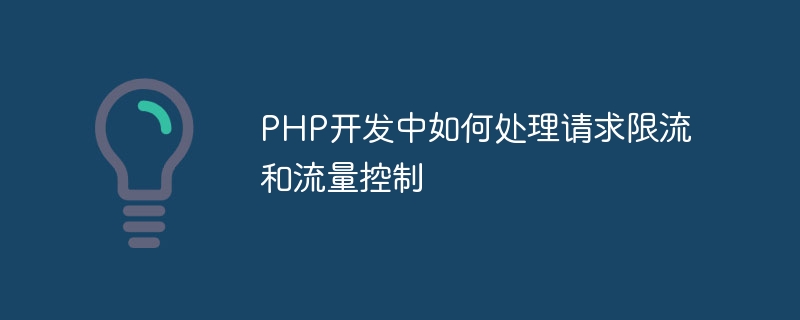

How to handle request limit and flow control in PHP development requires specific code examples
With the increasing number of Internet users, the traffic faced by websites and applications The pressure is also increasing. In order to protect the stability and performance of the server, we need to limit the flow of requests and control the flow. This article will introduce how to handle request current limiting and flow control in PHP development, and provide specific code examples.
1. Request current limiting
Request current limiting refers to limiting the access frequency to prevent malicious requests and high concurrent requests from causing excessive pressure on the server. The following is a code example of PHP request current limiting based on the token bucket algorithm:
capacity = $capacity; $this->rate = $rate; $this->tokens = $capacity; $this->lastRefillTime = time(); } public function allowRequest() { $currentTime = time(); $this->tokens = min( $this->capacity, $this->tokens + ($currentTime - $this->lastRefillTime) * $this->rate ); $this->lastRefillTime = $currentTime; if ($this->tokens < 1) { return false; // 桶中没有足够的令牌 } $this->tokens--; return true; // 可以处理请求 } } // 使用示例 $rateLimiter = new RateLimiter(10, 2); // 桶容量为10,每秒产生2个令牌 if ($rateLimiter->allowRequest()) { // 处理请求 echo "处理请求"; } else { // 请求限流,返回错误信息 echo "请求限流"; } ?>
In the above code, the RateLimiter class represents a request current limiter, which sets the bucket capacity and the number of tokens generated per second through the constructor. Number of cards. The allowRequest() method is used to determine whether the request can be processed. If there are enough tokens in the bucket, it will reduce one token and return true; otherwise, it will return false, indicating that the request is flow-limited.
2. Traffic Control
Traffic control refers to balancing server load and user experience by limiting the access speed of each user. The following is a code example of PHP traffic control based on the token bucket algorithm and counter algorithm:
capacity = $capacity; $this->rate = $rate; $this->tokens = $capacity; $this->lastRefillTime = time(); $this->waitingRequests = []; $this->counters = []; } public function allowRequest($userId) { $this->refillTokens(); if ($this->tokens < 1 || $this->exceedsRateLimit($userId)) { $this->waitingRequests[$userId][] = time(); return false; // 请求被限流 } $this->tokens--; $this->counters[$userId]++; return true; // 可以处理请求 } private function refillTokens() { $currentTime = time(); $this->tokens = min( $this->capacity, $this->tokens + ($currentTime - $this->lastRefillTime) * $this->rate ); $this->lastRefillTime = $currentTime; } private function exceedsRateLimit($userId) { $count = $this->counters[$userId] ?? 0; return $count >= $this->rate; } } // 使用示例 $trafficController = new TrafficController(10, 2); // 桶容量为10,每秒产生2个令牌 // 用户A发起请求 $userIdA = 1; if ($trafficController->allowRequest($userIdA)) { // 处理请求 echo "处理请求"; } else { // 请求被限流,返回错误信息 echo "请求被限流"; } // 用户B发起请求 $userIdB = 2; if ($trafficController->allowRequest($userIdB)) { // 处理请求 echo "处理请求"; } else { // 请求被限流,返回错误信息 echo "请求被限流"; } ?>
In the above code, the TrafficController class represents a traffic controller, which sets the bucket capacity and the generated traffic per second through the constructor. Number of tokens. The allowRequest() method is used to determine whether the request can be processed. If there are enough tokens in the bucket and the user's access count does not exceed the limit, then reduce one token and increase the user's access count; otherwise, add the request to the waiting queue and Returning false indicates that the request is flow-limited.
Summary
This article introduces how to handle request current limiting and flow control in PHP development, and provides specific code examples. Request current limiting and flow control are important means to protect server stability and performance. In actual projects, developers can choose appropriate algorithms and parameters for configuration according to needs. Please note that in an actual production environment, comprehensive protection needs to be combined with other protective measures and server configuration.
The above is the detailed content of How to handle request current limiting and flow control in PHP development. For more information, please follow other related articles on the PHP Chinese website!